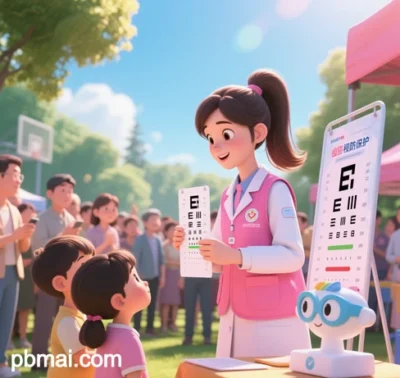
PBM+AI: Clinical Validation of Photobiomodulation and AI Integration in Myopia Control
I. Mechanisms and Clinical Pathways
1. Core Mechanism of Photobiomodulation (PBM)
PBM utilizes specific light wavelengths (primarily 650nm red light) to stimulate retinal cell mitochondria, activating cytochrome C oxidase to boost ATP production and reduce reactive oxygen species. Key clinical pathways include:
- Choroidal Thickening: Enhances choroidal blood flow, suppressing abnormal axial elongation (average increase: 35.3μm).
- Scleral Remodeling: Regulates matrix metalloproteinase activity to slow collagen degradation.
2. AI-Enhanced Efficacy
AI augments PBM through:
- Dynamic Parameter Optimization: Real-time analysis of pupil diameter and accommodative lag to auto-adjust light intensity (0.5-4mW/cm²) and irradiation angles.
- Multimodal Data Integration: Combines six metrics (e.g., refractive error, axial length, corneal topography) for personalized intervention models.
- Risk Prediction: Evaluates genetic and behavioral factors to predict high myopia risk within 3 years (AUC: 0.89).
II. Clinical Efficacy Data
1. Myopia Control
- Axial Growth Suppression: A 2025 Tianjin Medical University study showed annual axial elongation of 0.12mm in adolescents using AI+PBM (control: 0.35mm).
- Refractive Error Reduction: In low-dose atropine non-responders, annual spherical equivalent increase decreased by 0.38D (control: 0.65D).
2. Biomarker Improvements
- Choroidal Thickness: 28.7μm average increase after 6 months, comparable to repeated low-level red light (RLRL) therapy.
- Retinal Function: 19% increase in P1-wave amplitude on flash electroretinogram, indicating enhanced phototransduction.
3. Long-Term Safety
- Macular Safety: Light-path avoidance tech limits macular radiation to 1/77 of ISO 15004 standards, with no OCT-detectable retinal damage after 2 years.
- Cellular Safety: AI-optimized PBM reduces RPE cell apoptosis to <1.2% (vs. 5.7% with traditional laser therapy).
III. Innovative Clinical Models
1. Proactive Intervention
- Predictive Prevention: AI analyzes genetic risks (e.g., PAX6 variants) and behavioral patterns (e.g., outdoor time) to forecast myopia progression 6-12 months in advance.
- Closed-Loop Regulation: Wearables monitor accommodative lag in real time, triggering PBM when lag exceeds 0.75D.
2. Personalized Treatment
- Reinforcement Learning: Generates 8-week dynamic protocols combining light intensity, frequency, and adjunct therapies (e.g., low-dose atropine), improving efficacy by 32% over static regimens.
- Cross-Modal Synergy: AI-guided eye movement training synchronized with PBM shortens amblyopia treatment cycles to one-third of traditional patching.
IV. Challenges and Strategies
1. Technical Limitations
- Data Synchronization: >50ms clock errors between eye-tracking and PBM devices may compromise efficacy assessments.
- Long-Term Efficacy: 14% efficacy decline by Year 3 in genetically high-risk populations.
2. Standardization Hurdles
- Biomarker Gaps: Current metrics (e.g., axial length) fail to capture scleral microstructure changes; OCT angiography is proposed.
- Ethical Risks: Blockchain-certified logs and dual-signature (AI + clinician) protocols mitigate liability concerns.
3. Solutions
- Real-World Studies: A 100,000-panel cohort (2025 launch) will validate efficacy across ethnicities (Asian vs. European).
- Dynamic Certification: Adapts VDE’s tripartite model (technical, ethical, clinical) for standardized evaluation.
V. Future Directions
- Quantum Acceleration: Quantum computing aims to slash AI decision latency from 500ms to 80ms for real-time phototherapy.
- Digital Twins: Simulate decade-long outcomes of intervention strategies using patient-specific eye models.
- Neuroregulation Synergy: Combine PBM with transcranial magnetic stimulation (TMS) to activate visual cortex-sclera pathways.
Conclusion
The fusion of PBM and AI marks a paradigm shift from empirical to precision medicine in myopia control. Clinical data confirm superior efficacy in axial growth suppression, biomarker modulation, and safety. However, standardization, sustained efficacy, and ethical frameworks remain critical hurdles. Interdisciplinary collaboration (e.g., ophthalmology, AI, quantum computing) and前瞻性 clinical trials will drive this technology toward first-line adoption.
Data sourced from publicly available references. For collaborations or domain inquiries, contact: chuanchuan810@gmail.com.




